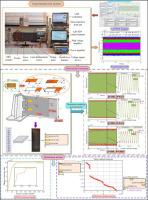当前位置:
X-MOL 学术
›
Appl. Acoust.
›
论文详情
Our official English website, www.x-mol.net, welcomes your feedback! (Note: you will need to create a separate account there.)
A method of layout optimization for MFC actuators in active vibration control of composite laminates
Applied Acoustics ( IF 3.4 ) Pub Date : 2024-03-08 , DOI: 10.1016/j.apacoust.2024.109961 Hui Zhang , Wei Sun , Haitao Luo , Jia Shen , Rongfei Zhang
Applied Acoustics ( IF 3.4 ) Pub Date : 2024-03-08 , DOI: 10.1016/j.apacoust.2024.109961 Hui Zhang , Wei Sun , Haitao Luo , Jia Shen , Rongfei Zhang

|
The configuration and optimization of actuators are essential to improve the control performance in active vibration control. In this paper, flexible composite laminates with multiple macro fiber composites (MFC) actuators are used as an example to study the position optimization of the MFC actuators on the structural surface. The dynamics model of the above structure is established using classical laminate theory and Hamilton’s principle, which can be used as the basic model in the subsequent optimization analysis. For the establishment of the optimization model, firstly, the performance index of the controllability grammian matrix eigenvalue is adopted as the optimization criterion to establish a single objective optimization model; secondly, a multi-objective optimization model is established based on the reciprocal of the controllability grammian matrix eigenvalue and the weighted value of the natural frequency changes of each order with or without MFC actuator on the structure surface; finally, based on the idea of the penalty function, a geometric constraint is proposed to prevent position interference between each actuator. A linear quadratic regulator (LQR) is designed for active vibration control of flexible composite laminates. Experimental systems for modal testing and active control response testing are built. By comparing the solution results of the basic model with the experimental test results, it is found that the maximum error of the first four natural frequencies is 7.9%, and the vibration response error of the structure with or without active control is kept at about 15%, which fully proves the correctness of the basic model. Finally, the two optimization models are solved and analyzed to verify the rationality of the optimization model and the necessity of considering the influence of the actuator position on the natural frequency of flexible matrix structure.
中文翻译:

复合材料层合板主动振动控制中MFC执行器布局优化方法
执行器的配置和优化对于提高主动振动控制的控制性能至关重要。本文以具有多个宏纤维复合材料(MFC)驱动器的柔性复合材料层合板为例,研究MFC驱动器在结构表面上的位置优化。利用经典层合板理论和哈密顿原理建立了上述结构的动力学模型,可以作为后续优化分析的基本模型。在优化模型的建立中,首先采用可控性格拉姆矩阵特征值的性能指标作为优化准则,建立单目标优化模型;其次,基于可控性格拉米亚矩阵特征值的倒数和结构表面有无MFC执行器时各阶固有频率变化的权重值,建立了多目标优化模型。最后,基于罚函数的思想,提出了几何约束来防止各个执行器之间的位置干扰。线性二次调节器 (LQR) 设计用于柔性复合材料层压板的主动振动控制。搭建了模态测试和主动控制响应测试实验系统。通过将基本模型的求解结果与实验测试结果进行对比发现,前4个固有频率的最大误差为7.9%,无论有无主动控制,结构的振动响应误差均保持在15左右。 %,充分证明了基本模型的正确性。最后对两个优化模型进行求解和分析,验证优化模型的合理性以及考虑执行器位置对柔性矩阵结构固有频率影响的必要性。
更新日期:2024-03-08
中文翻译:

复合材料层合板主动振动控制中MFC执行器布局优化方法
执行器的配置和优化对于提高主动振动控制的控制性能至关重要。本文以具有多个宏纤维复合材料(MFC)驱动器的柔性复合材料层合板为例,研究MFC驱动器在结构表面上的位置优化。利用经典层合板理论和哈密顿原理建立了上述结构的动力学模型,可以作为后续优化分析的基本模型。在优化模型的建立中,首先采用可控性格拉姆矩阵特征值的性能指标作为优化准则,建立单目标优化模型;其次,基于可控性格拉米亚矩阵特征值的倒数和结构表面有无MFC执行器时各阶固有频率变化的权重值,建立了多目标优化模型。最后,基于罚函数的思想,提出了几何约束来防止各个执行器之间的位置干扰。线性二次调节器 (LQR) 设计用于柔性复合材料层压板的主动振动控制。搭建了模态测试和主动控制响应测试实验系统。通过将基本模型的求解结果与实验测试结果进行对比发现,前4个固有频率的最大误差为7.9%,无论有无主动控制,结构的振动响应误差均保持在15左右。 %,充分证明了基本模型的正确性。最后对两个优化模型进行求解和分析,验证优化模型的合理性以及考虑执行器位置对柔性矩阵结构固有频率影响的必要性。



























 京公网安备 11010802027423号
京公网安备 11010802027423号